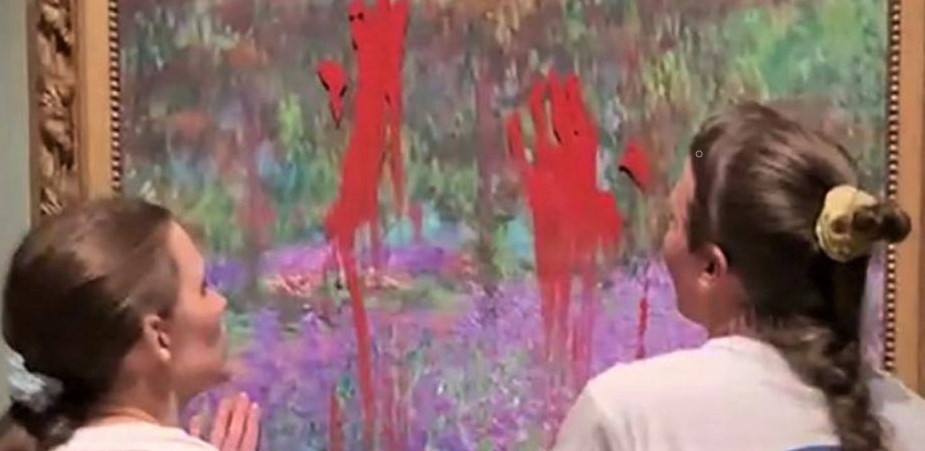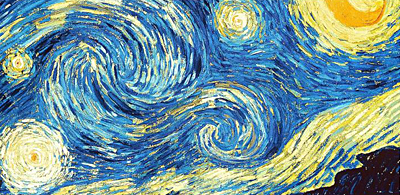Eco-Vandals Attack Monet Painting at Stockholm Museum
On June 14, 2023, two women from the eco-extremist group Återställ Våtmarker (Restore Wetlands), raided the National Museum in Stockholm, Sweden. They attacked Le Jardin de l’artiste à Giverny (The artist’s garden at Giverny), a painting created in 1900 by the French Impressionist Claude Monet.
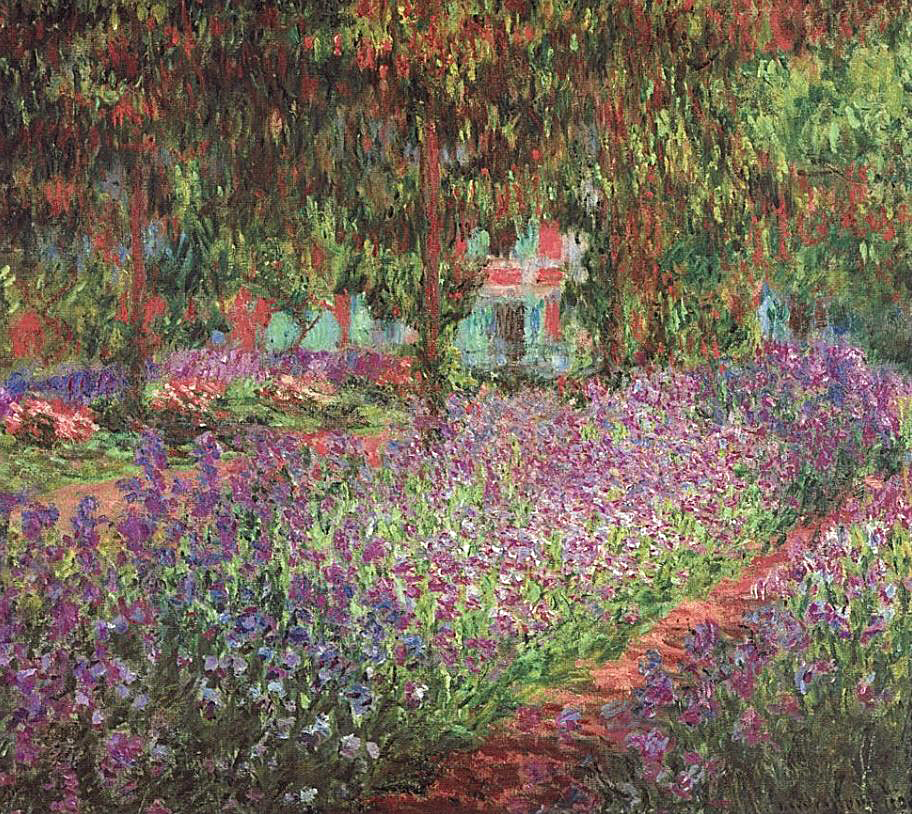
The two vandals, a 28-year-old nurse and a 25-year-old nursing student, wore white T-shirts emblazoned with the logo of Restore Wetlands. They smeared handfuls of thick red paint on the painting’s protective glass covering, then glued their hands to it. The two then lectured museum goers on the climate collapse disaster they believe is imminent.

In covering the story, every report from the corporate media—including the art press, referred to the perpetrators as “environmental activists.” Let’s get this straight, they are NOT activists… they are vandals.
The two were arrested by the Stockholm Police, who released this statement: “The crime is currently classified as aggravated vandalism. It is unclear whether more people than the two arrested are involved in the incident, but a number of people have been checked and the police will, among other things, review the course of events with the help of the museum’s surveillance cameras.”
The Stockholm Police later updated their statement, saying those arrested were charged with “suspicion of serious damage” to Monet’s painting.
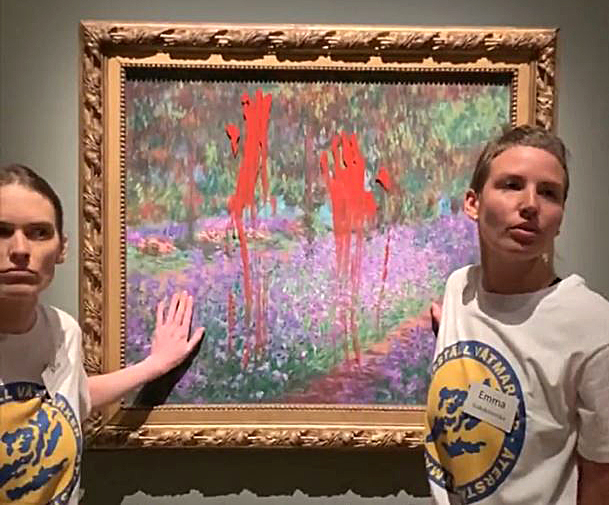
Monet’s The artist’s garden at Giverny was on loan from the Musée d’Orsay in Paris, France—which owns the artwork. It was granted temporary use for the National Museum’s exhibit The Garden – Six Centuries of Art and Nature. In the aftermath of the vandalism, restorers from the National Museum and the Orsay determined that the painting had not been damaged. However, Per Hedström, the acting Superintendent at the National Museum, made a statement:
“We naturally distance ourselves from actions where art or cultural heritage risks being damaged. Cultural heritage has a great symbolic value and it is unacceptable to attack or destroy it, regardless of the purpose.”
Kristina Axén Olin, a member of the center-right Moderate Party and a member of the Riksdag (Swedish parliament), had this to say about the eco-vandal assault on the Monet canvas:
“This risks turning the entire population into opponents of wetlands, or whatever it is you are trying to manifest. I hope that even environmental activists begin to feel that a line has now been crossed, that they choose instead to have a constructive discussion where it belongs, in order to achieve results.”

Claude Monet (1840–1926) was the founder of Impressionism. His 1872 painting Impression, soleil levant (Impression, Sunrise) was an atmospheric glimpse of ships in port with a morning sun blazing through the gray mist of dawn. The title of the painting inspired the word Impressionist, it would characterize the type of artworks Monet and those who followed him were creating.
Impression, soleil levant is now housed at the Musée Marmottan Monet in Paris, France. The museum is dedicated to the art of Monet, and it holds the largest collection of his paintings in the world. It also has a stunning collection other Impressionist artists like Berthe Morisot, Degas, Gauguin, and Renoir.

By 1890 Monet had enough money to purchase a house in the village of Giverny, situated on the right bank of the river Seine in the Normandy region. There he created a magnificent garden with flower beds, water gardens, paths, ponds, and bridges. Today the Foundation Claude Monet runs the property as a museum, and the artist’s house, gardens, and expansive studio were he created his paintings are open to the public.

I once visited the Musée Marmottan Monet, and recall being captivated by two groups of Monet’s paintings, his Rouen Cathedral series, and his Water Lilies series. Starting in 1892 Monet began painting the Rouen Cathedral in Normandy, France. The cathedral has existed for over eight hundred years, and it displays the architectural styles of the centuries.
Monet concentrated on painting just the façade of the Cathedral, but he did so at different times of the day and year. He effectively painted the effects of light on the building, not the structure itself. There are more than thirty large canvases in the Rouen series—though not all of them are at the Marmottan.
I remember standing transfixed in front of his Rouen Cathedral at sunset on display at the Marmottan, a marvelous work in oranges and blues painted on raw beige linen. Up close it is all smears, blotches, and squiggles, but seen from a few feet back it becomes the ancient Cathedral bathed in translucent golden light.
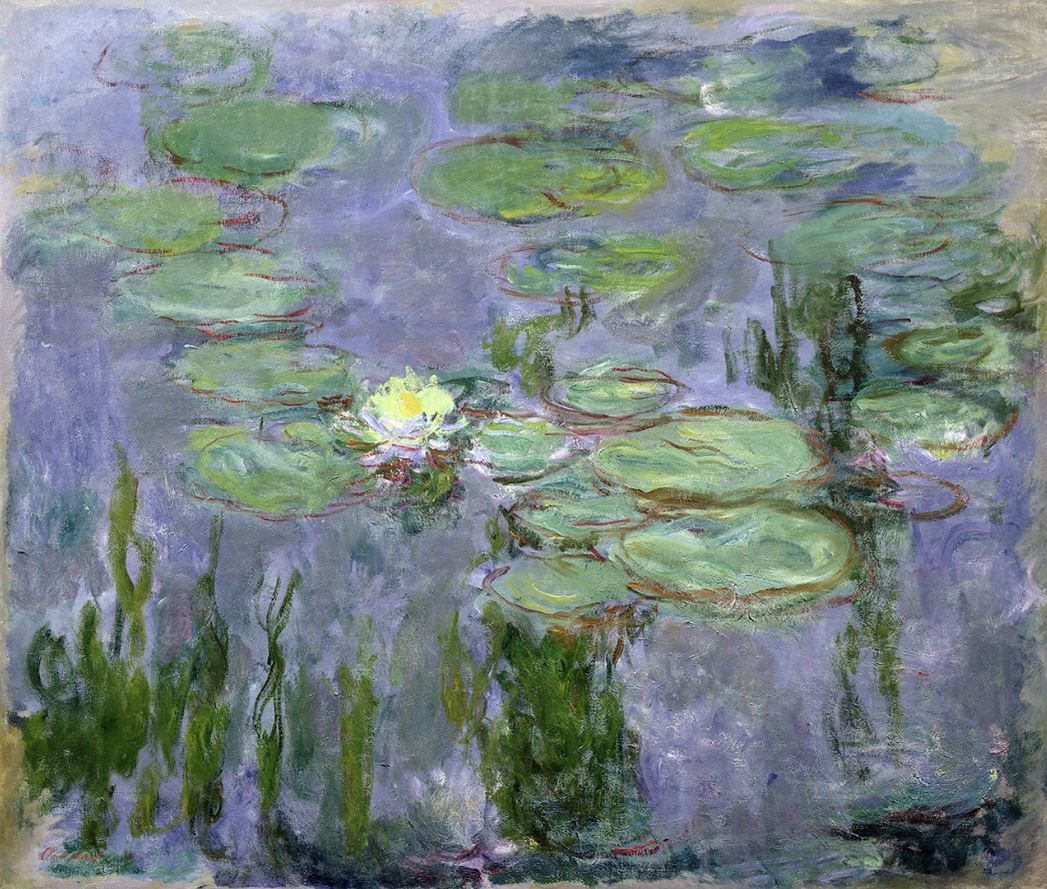
The other fantastic series painted by Monet was his Water Lilies series, these were painted from his Giverny flower garden. There are some 250 canvases in this series, works done in the last years of his life. As with the Rouen Cathedral paintings, the Water Lilies series shows the water lily ponds at various times of day… but these paintings present transcendent nature in all of its glory.
But of course, none of this matters to the dullards of Restore Wetlands.
The Restore Wetlands cadre viewed Le Jardin de l’artiste à Giverny as a picture made by some dead white guy from long ago—to them, the painting’s only value was being a prop in their moronic transgressive act.
The first action by Restore Wetlands took place on May 29, 2023, it will correctly be remembered as a buffoonish spectacle. Three members of the group tried to take control of Sweden’s popular competition TV show Let’s Dance; a showcase that features celebrities dancing with professional dancers. In this case skier Charlotte Kalla was dancing with professional dancer and choreographer Tobias Karlsson when the “activists” stormed the stage.
Let’s Dance cameraman lowers the boom on Återställ Våtmarker.
One disrupter tossed clouds of yellow colored pigment into the air, another held a yellow banner that read Återställ Våtmarker (Restore Wetlands), and the third attempted to film the theatrics. All throughout the frenetic interruption Charlotte Kalla and Tobias Karlsson didn’t miss a step, their dancing never ceased.
As the three crazies attempted to sabotage the dance performance, a cameraman controlling a “boom shot” camera on a large crane, swung the device into the fellow holding the banner—quickly ending the so-called “protest.” Since a boom shot in cinematic parlance is a film camera assisted by a crane to achieve unique camera perspectives, let’s just say the Let’s Dance cameraman gave new meaning to the phrase… lower the boom.
When we discuss topics like Impressionism and the history of European painting, we are in essence talking about Western Civilization. The arts and sciences are the very definition of civilization—this is not arguable. Yet, our museums are being raided by “environmental activists” who for political reasons threaten and violate the art treasures of the West. Hooligans like Restore Wetlands are contemptuous of the Western world and plainly wish to eradicate it.
Artists have made enormous contributions to world culture. They have for centuries revealed beauty where others did not see it, illuminated truth when many denied it, uncovered hidden savagery, and evidenced the spirituality of the human heart. Artists and their works have been a civilizing force. That is why, in the end, the eco-vandals will not be victorious.
~~~~ # ~~~~
UPDATE: Dec. 7, 2025. As it turned out, there were six members of Restore Wetlands involved in the vandalization of the Monet painting The Artist’s Garden at Giverny. All six admitted to participating in the vandalism. On Dec. 7, 2025 a Swedish court freed all six, saying the group did not intend to cause any lasting damage to the painting, even though paint damaged the frame. The charges were dropped and group members were not required to pay for damages.
Per Hedström, a representative for the National Museum in Stockholm, would not comment on the ruling, but cautioned that it would be interpreted “as a signal that it is okay to do something like this.” He noted, “This is part of a broader threat to cultural institutions, which is driving up the costs of security arrangements.”


